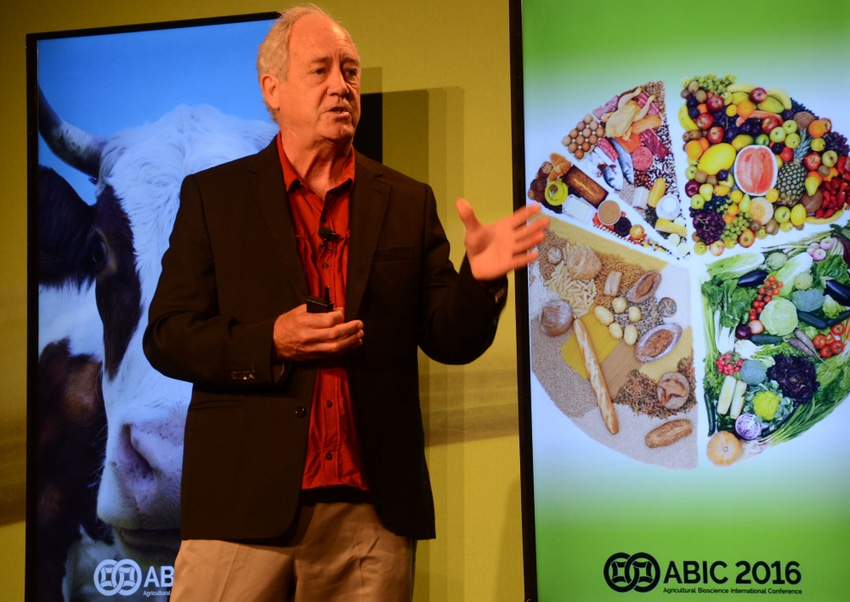September 20, 2016

It's not news that Patrick Moore is frustrated with the folks at Greenpeace. While he was an original founder of the group, and in speeches touts the work he did to help save the whales, and protect baby seals, he parted ways when the organization focused more on the "green" in its name rather than the "peace." And all of his focus now is on Golden Rice.
During the Agricultural Bioscience International Conference being held in Fargo this week, Moore took on the notion of anti-GMO activists; but his core cause is Golden Rice.
Farmers will remember Golden Rice. News of the idea of engineering rice so that it produced beta carotene, which the human body turns to valuable Vitamin A was greeted with optimism and excitement more than a decade ago. But like one of those documentaries that asks "whatever happened to golden rice" the product sort of fell off the radar.
Not in rice-centric countries where the crop – if cultivated – could save as many as 2 million children a year, Moore says. However, Greenpeace and other like groups have taking on the Golden Rice fight as a standard bearer in their war on GMO crops and Moore is none too happy. In fact, he's created a movement – Allow Golden Rice Now - in opposition to the efforts to stop the crop.
"They're linking Golden Rice with death, which scares parents into not wanting the technology developed, and they're still doing this today," Moore says. It was those efforts, and the fact that no one was actively campaigning in favor of the technology that led Moore to create the group supporting development of the crop.
Background on plant breeding
From a technology standpoint, Moore talks about the fear-mongering against GMOs that goes against the actual science of what's happening in the world – and has happened for more than 10,000 years. He points to directed genetic modification, which farmers have been doing for centuries. Then points to the mutation breeding that has been going on for the past 100 years. "We've used chemicals and radiation to scramble the genetics of an organism, then we plant them and see if anything interesting comes up," he says.
That shotgun approach led to the development of a range of crops – including durum wheat, developed from radiation mutation. "But that idea doesn’t even register in this argument," Moore says.
We've evolved the science of plant breeding to much more targeted approaches including marker-assisted breeding and recombinant DNA, which Moore prefers to call horizontal gene transfer. "Opponents to GMOs will tell you that horizontal gene transfer doesn’t happen in nature. It's been happening for billions of years with bacteria, which is the same way we do it," he says.
Genetic tools in plant breeding include bacteria that can transfer targeted DNA into host plants and modify them with new traits. It's an effective tool for initial gene insertion, and has gotten much more precise since the early days of genetic engineering. But Moore notes that the anti-GMO groups have managed politically to compartmentalize this technology "as some special, horrible thing that scientists and multinational corporations do," he says.
Golden Rice facts and frustrations
As for Golden Rice, which by the way has been refined to have such a high level of beta carotene that just 40 grams of the rice in a child's diet daily – that's about 1.4 ounces – will provide enough Vitamin A to end the deficiency. Moore notes that Greenpeace has turned its tactics from the breeding to the idea that the crop doesn't work, which he says is also inaccurate, but unchallenged.
This is a root cause for Moore who adds that 250 million preschool children in developing countries are deficient in Vitamin A, which leads to more than 2 million deaths per year. He charges that Greenpeace is specifically responsible for the deaths of 20 million children through their decade-long anti-Golden Rice campaign.
"The only difference between Golden Rice and conventional rice is beta carotene. If this rice would cure dengue, malaria [or some other disease] it would have been approved in six months or a year," he says. "Medicine kills what's in you without killing you – here we're giving children an essential nutrient."
A range of charitable organizations is in favor of moving ahead with Golden Rice, but field trials have been attacked by well-meaning urbanites motivated by the Greenpeace "death notices," which has frankly stifled future development of the crop.
Moore may be frustrated by all this, but he's also optimistic that eventually scientists will develop GMO crops with a human benefit that can't be ignored. Soybean oil with Omega-3 content higher than fish oil was one idea – and that product is in the development pipeline at Monsanto.
He notes that the folks at Greenpeace call Golden Rice a "Trojan horse for GMOs" and that if it is show helpful to people it will make people more supportive of the technology. "Didn't the Trojans win that war?" he asks. "Me and the scientists are getting in the horse, come in there with us."
About the Author(s)
You May Also Like






